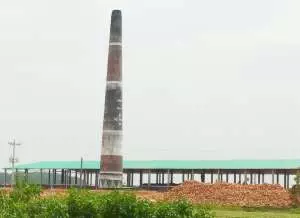1. Introduction: Brick kilns are the major concern of Bangladesh. With increasing population, demand for bricks for construction is also increasing. As a result, the brick industry/ factory is established as a booming industry. The study was conducted to evaluate the impact of a brick kiln on the environment, soil as well as on human beings. The study area was 3 no. Charbaria Union; Barishal Sadar, Barishal-8200. The brick kiln was situated near riverside. During the survey, it was noticed that plants, agricultural soil especially topsoil and surrounding air are badly affected.
*To know the impact of air pollution on human health and the environment caused by the brick kiln.
* To know the impact of soil pollution caused by the brick kiln
* To find out recommendations for solving the problems
3. Impacts of a brick kiln associated with the study area
3.1: Topsoil loss
The brick kiln removes topsoil for brick making. As a result, it has a direct impact on agricultural crop production by reducing the fertility status of the soil. The harmful effect of topsoil removal results in a reduction in agricultural output and increases the cost of replacing the nutrients lost.
Harmful gases that are released from the brick kilns to the environment alters the natural cycles such as nitrogen cycle and other natural processes which results in decreasing fertility, decreasing the change in composition and contents of nutrients in the soil. This change in nutrient concentration increases heavy metal contents in the soil which reduces the overall quality.
3.2: Polluting the air
World Bank (1997) reported that the main contributing sources for Total Suspend Particles (TSP) in the valley are cement factories (36%), brick kilns (31%) domestic fuel combustions (14%), road re-suspensions (9%) and vehicle exhausts (3.5%). The survey conducted that, the brick kiln is poorly designed which cause incomplete combustion of coals. This incomplete combustion produces Carbon Monoxide that is the major air pollutant. It also comprises fine dust particles, hydrocarbons, Sulphur Dioxide (SO2), Oxides of Nitrogen (NOx), Fluoride compounds.

3.3: Health Impacts
Brick kilns comprise a small number of carcinogenic dioxins. But it has a great contribution to emit particulate matter of size less than 10microns (PM10) concentration, which is responsible for damaging the respiratory system. In Bangladesh, it is reported that brick kilns produced PM2.5, (Guttikunda, 2009). This fine PM produced by the brick kiln is more harmful to human health. Exposure to air pollutants can break down natural defense mechanisms in the body, which cause respiratory diseases such as lung cancer, asthma, chronic bronchitis, and emphysema.
3.4: Others
From interviews with local people, it is found that local farmers have already experienced the problems of drying water sources, low water holding capacity on soils, poor crop stability, and reduced crop productivity in the study areas that have been used for brick factory. On average each kiln burn 350 tonnes of woods a year, so more kilns means having a devastating effect on the forests (Morley, 2012). Similarly, surrounding plant health is also affected due to air pollution caused by the brick kiln.
4. Conclusion and recommendations
It is clearly visible that the brick kiln causes environmental pollution and harmfully affected the local people. Introduction of cleaner technologies such as vertical shaft kilns and fixed chimney kilns, the substitution of traditional kilns with newer technologies are reducing air pollution. Along with air pollution reduction, these also reduce the impact on the environment and human health by the suggestion for standard emission from brick kilns.
5. References
- American Lung Association. (2006, January 30). 2005 Research Highlights: Health Effects of Particulate matter and Ozone Air Pollution. Retrieved from Northeastdiesel Organization.
- Impact of Brick Kilns’ Emission on Soil Quality of Agriculture Fields in the Vicinity of Selected Bhaktapur Area of Nepal, Gunjan Bisht and Sanjila Neupane, Applied and Environmental Soil Science, Volume 2015, Article ID 409401, 8 pages.
- Personal communication with local peoples of the study area of the brick kiln ( April 22, 2019)
Author:
Nargis Akter Shapna
Soil and Environmental Sciences
University of Barisal, Bangladesh